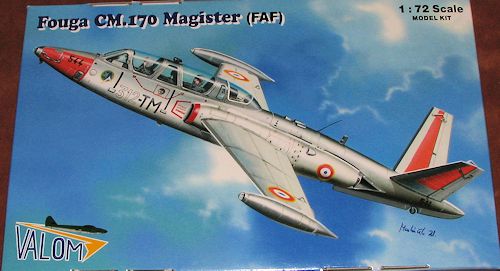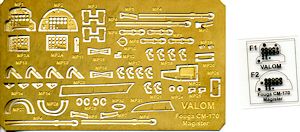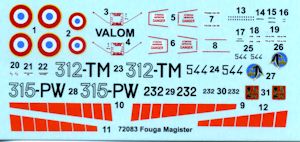
Valom 1/72 Fouga CM.170 Magister (FAF)
| KIT #: | 72083 |
| PRICE: | It seems to be selling for about 20 Euros in Europe. |
| DECALS: | Two options |
| REVIEWER: | Scott Van Aken |
| NOTES: | Short run kit with resin and photo etch parts. French Air Force version. |

| HISTORY |
The Fouga Magister (company designation CM.170) is a 1950s French two-seat jet trainer. The related CM.175 Zéphyr was a carrier-capable version for the French Navy.
Although it is sometimes lauded as the first purpose-built two-seat turbojet-powered trainer aircraft, similar claims are made for the Fokker S.14 Machtrainer whose first flight, production and service entry were all about a year earlier. However, the Magister was much more successful than the Machtrainer, being produced in far greater numbers and being exported to many nations. Nearly 1,000 Magisters were constructed compared to the 21 Machtrainers.
In 1948, Fouga designed a jet-powered primary trainer called CM.130 for the French Air Force (Armée de l'Air, AdA) to replace piston-engined Morane-Saulnier MS.475 aircraft. When AdA found the aircraft lacking in power from the two Turbomeca Palas turbojets, Fouga enlarged the basic design and used the more powerful Turbomeca Marboré engine. The distinctive V-tail of the new CM.170 Magister originated on the CM.8 (Aka Castel-Mauboussin 8) glider Fouga was using to experiment with jet engines. In December 1950, AdA ordered three prototypes, with the first aircraft flying on 23 July 1952. A pre-production batch of 10 were ordered in June 1953 followed by the first production order for 95 aircraft on 13 January 1954. Fouga built a new assembly plant at Toulouse-Blagnac to produce the aircraft. The aircraft entered service with AdA in 1956.
The Fouga Magister 170R was designed in 1949 by Robert Castello and Pierre Mauboussin. The first prototype flew on 23 July 1952 and the first one sold to AdA flew for the first time in February 1956.
Due to different industrial mergers, the aircraft has been known as the "Fouga CM.170 Magister", "Potez (Fouga) CM.170 Magister", Sud Aviation(Fouga) CM.170 Magister" and "Aérospatiale (Fouga) CM.170 Magister" depending on where and when they were built.
The French Navy's Aéronavale adopted a derivative of the Magister, the CM.175 Zéphyr, as a basic trainer for deck-landing training and carrier operations. These were preceded by two "proof of concept" prototypes designated the CM.170M Magister, which made their first flights in 1956/57.
An improved version of the Magister designated the CM.170-2 Magister was produced from 1960. It used a more powerful Turbomeca Marboré IV engine. Production of the Magister stopped in France in 1962 but it continued to be built in Finland up to 1967.
The development of the aircraft came to an end when the French Air Force selected the Alpha Jet as their new jet trainer.
After retirement, a number of Magisters were bought by private-owner pilots in the USA and are operated in the experimental category.
| THE KIT |
 Many
modelers will be pleased to see this new kit from Valom. From the look of
things, a variety of aircraft will be done in this series and we can hope that
some of the more interesting schemes will follow. This is not, of course, the
first time that we have seen the Magister kitted in 1/72, though it has been
over 30 years since those from
Many
modelers will be pleased to see this new kit from Valom. From the look of
things, a variety of aircraft will be done in this series and we can hope that
some of the more interesting schemes will follow. This is not, of course, the
first time that we have seen the Magister kitted in 1/72, though it has been
over 30 years since those from Airfix, Heller, and I believe Matchbox were done. So we
were needing a newer tool and more detailed kit.
Airfix, Heller, and I believe Matchbox were done. So we
were needing a newer tool and more detailed kit.
The kit provides a very nicely done cockpit that includes resin for the seats, photo etch instrument panels in which acetate instruments are sandwiched, and photo etch belts. Rudder pedals are also etched. Throttles and some other small bits are resin. In fact, you'll find quite a few very small resin parts for this kit, which makes it one that should only be built by a modeler who has had experience with very small pieces. All of this fits into a one-piece tub.
Intakes are left and right halves and there is a compressor face blanking plate for each side. The nose well is a flat plate that attaches to a bulkhead which itself attaches to the front of the cockpit tub. A rear bulkhead is provided for the back of the cockpit assembly. Separate wheel wells are provided and it appears they are a bit too thick as the instructions have you shave .25mm from each one. Now here is something that may be a deal breaker for some. You see, it appears that Valom's mold maker forgot to add in the various vents for the nose and the rear engine section. There are quite a few of these and it is up to the modeler to add these to the airframe. The instructions show you exactly where each one is to be added. Also to be added are a considerable number of vents, antennas, and control hinges. These are either resin or photo etch as appropriate. Even the attachment hinges for the gear doors are photo etch as are the oleo scissors. Also in p.e. is the keel for the back of the lower fuselage. To top all this off, Valom provides two different canopies. One is a single piece and the other allows the canopy section to be formed open. Apparently the canopy does not fit flush as the instructions have you bevel all the mating surfaces prior to attachment. You'll also find a few bits on the sprues that are not used.
 Markings are
provided for two aircraft, both in painted aluminum with orange bits on the tail
and nose. The bits on the nose will need to be painted. Please note that in the
case of the Magister, all the removeable panel lines were unpainted in painted
sections. Those two units were GE.312 as shown on the box art. The other was
GE.315. The Magister was used as a hack by many units and bases after they were
withdrawn from the training units so if you have a photo and a set of French
codes, you can do just about any Magister operated in France.
Markings are
provided for two aircraft, both in painted aluminum with orange bits on the tail
and nose. The bits on the nose will need to be painted. Please note that in the
case of the Magister, all the removeable panel lines were unpainted in painted
sections. Those two units were GE.312 as shown on the box art. The other was
GE.315. The Magister was used as a hack by many units and bases after they were
withdrawn from the training units so if you have a photo and a set of French
codes, you can do just about any Magister operated in France.
| CONCLUSIONS |
Nice to see this one being done. It is not a kit for beginners and I would have to put it into the 'experienced modeler' class due to all the tiny parts and the additional work it will take to bring things up to specs. If you have the ability and want what can easily be a real beauty, then this is the kit for you.
| REFERENCES |
http://en.wikipedia.org/wiki/Fouga_Magister
January 2014
Thanks to www.valom.cz
for the preview kit. Get yours at your local shop or on-line retailer. If you would like your product reviewed fairly and fairly quickly, please contact the editor or see other details in the
Note to
Contributors.